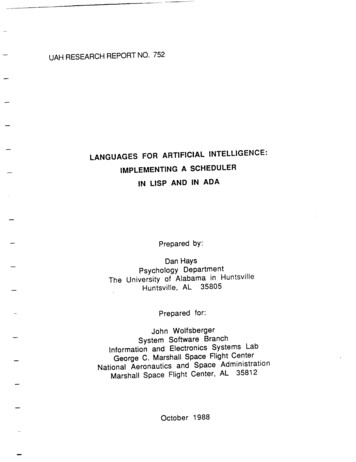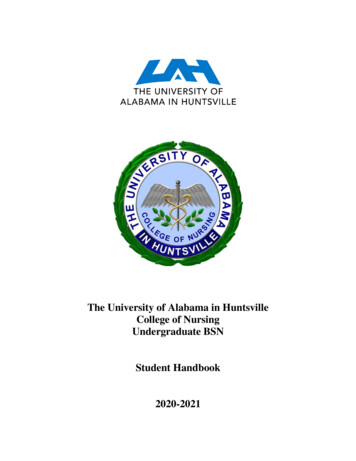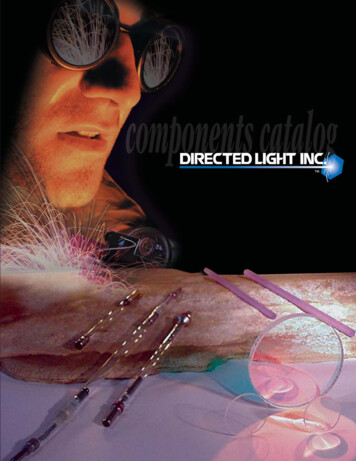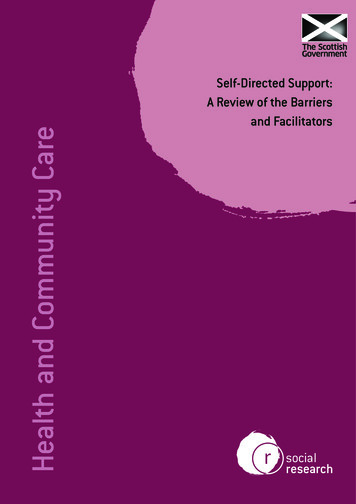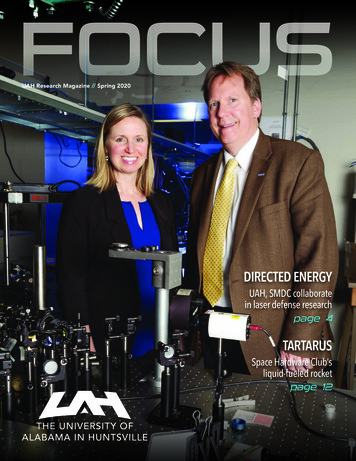
Transcription
FOCUSUAH Research Magazine // Spring 2020DIRECTED ENERGYUAH, SMDC collaboratein laser defense researchpage 4TARTARUSSpace Hardware Club’sliquid-fueled rocketpage 12
KEY CONTACTSVICE PRESIDENT FOR RESEARCHAND ECONOMIC DEVELOPMENTDr. Robert Lindquist(256) 824-2882Robert.Lindquist@uah.eduCENTER FOR APPLIED OPTICSDr. Pat ReardonDirector(256) 824-2530Patrick.Reardon@uah.eduASSOCIATE VICE PRESIDENTFOR RESEARCH ANDECONOMIC DEVELOPMENTDr. Thomas Koshut(256) 824-6100Tom.Koshut@uah.eduCENTER FOR CYBERSECURITYRESEARCH AND EDUCATIONDr. Tommy MorrisDirector(256) 824-6576Tommy.Morris@uah.eduOFFICE OF RESEARCH SECURITYDenise SpillerSecurity Administrator(256) 824-6444Denise.Spiller@uah.eduCENTER FOR SPACE PLASMAAND AERONOMIC RESEARCHDr. Gary ZankDirector(256) 961-7401Gary.Zank@uah.eduOFFICE OF SPONSOREDPROGRAMSGloria GreeneDirector(256) 824.2657Gloria.Greene@uah.eduEARTH SYSTEM SCIENCE CENTERDr. John ChristyDirector(256) 961-7763John.Christy@nsstc.uah.eduCONTRACTS AND GRANTSACCOUNTINGValarie KingDirector(256) 824-2231Valarie.King@uah.eduINFORMATION TECHNOLOGYAND SYSTEMS CENTERDr. Sara GravesDirector(256) 824-6064Sara.Graves@uah.eduOFFICE OF TECHNOLOGYCOMMERCIALIZATIONKannan GrantDirector(256) 824-6621Kannan.Grant@uah.eduPROPULSION RESEARCH CENTERDr. Robert FrederickDirector(256) 824-7200Robert.Frederick@uah.eduOFFICE OF ENVIRONMENTALHEALTH AND SAFETYKristy OliveDirector(256) 824-6053Kristy.Olive@uah.eduOFFICE FOR PROPOSALDEVELOPMENTDr. Virginia (Suzy) YoungDirector(256) 824-3448Suzy.Young@uah.eduRESEARCH INFORMATIONSYSTEMSRui GuoDirector(256) 824-2648Rui.Guo@uah.eduRESEARCH INSTITUTEDr. Steven MesservyDirector(256) 824-6881Steven.Messervy@uah.eduROTORCRAFT SYSTEMSENGINEERING ANDSIMULATION CENTERDave ArterburnDirector(256) 824-6846David.R.Arterburn@uah.eduSYSTEMS MANAGEMENTAND PRODUCTION CENTERDr. Gary MadduxDirector(256) 824-2679Gary. Maddux@uah.eduINVENTION TO INNOVATIONCENTERRigved JoshiDirector(256) 824-6058Rigved.Joshi@uah.edu
VPRED MESSAGEUAH research is ready to serveDr. Robert LindquistVP for Research and Economic DevelopmentWhen it comes to our nation’sdefense, The Universityof Alabama in Huntsville(UAH) is always ready to serve. That’swhy the university’s partnership withthe United States Space and MissileDefense Command (SMDC) in the fieldof directed energy is evolving under anew 5 million Congressional additionto the contract in fiscal year 2019 tofund two state of the art laser labs inthe Center for Applied Optics throughfiscal year 2021.SMDC and UAH scientists areco-located and working collaborativelyin the Optics Building to developlasers and the next generation of laserexperts for roles in national defense.On page 4, we learn about the researcheffort, which complements UAH workin hypersonics and artificial intelligence,two additional top military priorities.An amazingly multi-faceted researchenterprise at UAH is grounded inthe work of our faculty and staff, andon page 10 we find out about eightnew tenure-track faculty who wereawarded a total of 79,622 in 2019-20New Faculty Research awards fromthe Office of the Vice President forResearch and Economic Development.Likewise, on page 8 we learn that aUAH pioneer in the field of wearablehealth monitoring has been selectedas a Fellow by the Institute of Electricaland Electronics Engineers (IEEE) forhis contributions. Dr. Emil Jovanov,an associate professor of electricaland computer engineering and anAlabama Inventor of the Year, was thefirst to propose Wireless Body AreaNetworks (WBAN) as a sensor systemto communicate through the Internetfor health monitoring.On page 11, we find out aboutresearch to assist South Asian countries in air quality monitoring led byDr. Aaron Naeger (MS, AtmosphericScience, 2010; Ph.D., AtmosphericScience, 2013), the science principalinvestigator, who also is a researchscientist in UAH’s Earth System ScienceCenter (ESSC) and a lead aerosoland air quality scientist with NASASPoRT. The work has attracted athree-year, 750,000 NASA ResearchOpportunities in Space and EarthScience (ROSES-19) grant.Award-winning research by a UAHdoctoral student shows that the undulating flight paths of Monarch butterfliesare actually more energy efficient thana straight-line path, and on page 14 welearn that the discovery can be valuablein the bio-inspired design of long-rangerobotic miniature drones.The UAH Center for Space Plasmaand Aeronomic Research (CSPAR) isanalyzing massive data streams fromNASA’s Parker Solar Probe and theEuropean Space Agency (ESA) SolarOrbiter, and on page 16 we findthat CSPAR director Dr. Gary Zank islooking ahead to NASA’s InterstellarMapping and Acceleration Probe(IMAP), set for a 2024 launch.Coastal cities can be spared somewind destruction from intensifying hurricanes or tropical storms if functionalwetland ecosystems and agriculturalcroplands are in the area, accordingto computer modeling research ledby UAH associate professor of atmospheric science Dr. Udaysankar Nairthat’s on page 18.Dr. Matthew Niemiller, a UAH assistant professor of biological sciences,found an Alabama Cave Shrimp,Palaemonias alabamae, during a biological survey of Fern Cave in summer2018, and on page 20 we find that theendangered shrimp was only knownbefore in six caves in Madison County.In student research, a page 12 storysays that new tests are underway for anambitious liquid propellant rocket beingengineered by UAH’s Space HardwareClub (SHC), which hopes its vehicle willlaunch at the 2021 Spaceport AmericaCup competition for student rocketryteams in New Mexico.Why does psychological researchshow a jury bias toward believingjailhouse informants? On page 22,three UAH graduate students examinea fundamental question: How do juriesweigh jailhouse informant testimonywhen deciding guilt or innocence?We are proud of the accomplishments of our faculty, staff, studentsand alumni. We are excited about thefuture and welcome collaborative partnerships. Please contact the Office ofResearch and Economic Developmentto be provided more information onthe efforts featured in this magazine orany other research project at UAH.UAH.EDU/RESE ARCH1
POINTS OF PRIDETHE UNIVERSITY OF ALABAMA IN HUNTSVILLEA RESEARCH INTENSIVE national university that servesas the anchor tenant of the second–largest research parkin the United States, UAH is considered one of the nation’spremier research universities./ IN ALABAMAst/ NATIONALLY5thFederally financed AerospaceEngineering research8thEconomics researchIN ALABAMAEnvironmental sciences, includingAtmospheric sciencesMath & Computer sciencesPhysical sciencesNDIN ALABAMAFederally funded researchexpenditures11thNASA-sponsored research11thComputer and Information Sciencesresearch12thAtmospheric Sciences research12thAstronomy & Astrophysics research28thDepartment of DefenseR&D expendituresSOURCE: National Science Foundation/RESEARCH 489 million 109.7 millionOver 2 million[ISSUED patent total – 112]Five-year contract and grant research totalFive-year license and royalty revenue total2FOCUS // UAH RESE ARCHFiscal 2019 research expenditure total
TABLE OF CONTENTSCOVER4DIRECTED ENERGYUAH and SMDC research lasers for national defenseFACULTY FOCUS8NEW FELLOWIEEE picks wearable health monitor pioneer Dr. Emil Jovanov10NEW FACULTY RESEARCHEight get UAH funds to continue innovative science11TRACKING AIR QUALITYNASA funds South Asia work by Dr. Aaron Naeger and teamSTUDENT FOCUS12TARTARUSSpace Hardware Club developing liquid fueled rocket14EFFICIENT FLIGHTButterfly’s energy saving undulations may help dronesRESEARCH FOCUS16GOOD DAY SUNSHINECSPAR crunches big data from solar probes, looks ahead18BUFFERING THE BLOWNearby wetlands and crops can mitigate city storm damage20HOW’D THAT GET HERE?Discovery of rare shrimp in new location raises questions22TRUSTING A SNITCHHow do juries weigh jailhouse informant testimony?24MAKING THE CONNECTIONCPU2AL joins smart interns with Alabama industriesCover: Amanda Clark, high-energy laser enabling technology lead for the U.S.Army Space and Missile Defense Command, with Dr. Robert Lindquist, UAH’svice president for research and economic development, in the Laser Source andAtmospheric Propagation Laboratory at the UAH Center for Applied Optics.UAH.EDU/RESE ARCH3
COVER STORYA test piece from a different lab showsthe power of laser directed energy.4FOCUS // UAH RESE ARCH
COVER STORYWesley Barnes, left, and UAH lab leadDr. James Hadaway work on laser setupin the Beam Control System IntegrationLaboratory.DIRECTEDENERGYUAH and Space and Missile Defense Commandcollaborate on key future defense componentDirected energy (DE) has been identifiedas an integral part of future UnitedStates defense capabilities by the U.S.Department of Defense (DoD). DE is the capabilityto harness the power of the electromagneticspectrum to effectively and affordably strikecritical targets at the speed of light. Rather thanbullets or projectiles, the two classes of DE rely onhigh-energy lasers and high-powered microwavesystems to neutralize threats.The DoD is interested in DE technologies becausethey offer the warfighter the attributes of speed,range, flexibility and precision. DE weapons canstrike at the speed of light, engage multiple targetsand deliver a deep magazine of microwave orkinetic ammunition with exceptional accuracy andreduced logistical support.As part of the effort to develop such capabilities,two High Energy Laser Research Laboratories inthe Center for Applied Optics (CAO) in UAH’sOptics Building represent an evolution in the DElaser research collaboration between UAH and theU.S. Army Space and Missile Defense Command(SMDC). The partnership began in 2011 and the firstresearch was conducted on UAH’s campus in 2013.Under a 47 million, five-year AdvancedTechnology, Test and Development contractthat SMDC has with UAH, the Laser Source andAtmospheric Propagation Laboratory and the BeamControl System Integration Laboratory will conductresearch and development, experimentation, andevaluation of High Energy Laser (HEL) components,subsystems and supporting phenomenology. Bothlabs bring world-class, state-of-the-art capabilities tothe UAH campus.U.S. Sen. Richard Shelby was instrumental inobtaining a 5 million Congressional addition to thecontract in fiscal year 2019 to fund the labs throughfiscal year 2021.The Laser Source and Atmospheric PropagationLaboratory is home to a 3-kilowatt laser andresearches a variety of optical fiber cable, includingytterbium-doped fiber amplifiers.UAH.EDU/RESE ARCH5
COVER STORY“These high-power fiber amplifiers arecapable of producing kilowatts of outputpower without resorting to multimode operation, which is important when the laser willbe used in conjunction with a beam controlsystem and propagated over long ranges,”says Carl Sanderson (BSE, Optical Engineering,2013), the principal investigator for the SMDCHEL Division’s laser source and atmosphericpropagation efforts at UAH and a researchengineer with UAH’s Systems Managementand Production (SMAP) Center.“This isappliedresearchthat willhelpimprovecapabilitiesfor nextgenerationdirectedenergysystems.”Lasers work by creating a high-energykinetic effect to concentrate intense heat ona targeted area, so it’s important to accuratelyaim that energy. In the Beam Control SystemIntegration Laboratory, research includes targetacquisition, target tracking, pointing of thehigh-energy laser and correction of atmospheric turbulence effects. The lab has newstate-of-the art optical metrology instrumentsthat will be used to test optical componentsneeded for its beam control work.“The goal is to investigate new hardwareand control algorithms in our laboratory todetermine which ones show enough promiseto move on to further development andtesting,” says Dr. James Hadaway (Ph.D.,Optical Science & Engineering, 2004), the lab’sUAH lead. “As with any weapon system, it isparamount that any potential target is firmlyestablished as a threat, and that the weaponis accurately aimed at the intended target,without endangering friendly assets, beforethe high-energy laser is actually fired at thetarget. And all of that must occur in a veryshort amount of time.”Much has been done to advance the technology to the point that reliable laser weaponscan be put into regular use on the battlefield,Dr. Hadaway says, but research continues torefine and perfect aiming accuracy.6FOCUS // UAH RESE ARCH“One of our main goals is to make significantcontributions to this advancement,” he says.“We are also evaluating methods to safelyabort high power laser operations when thelaser beam goes astray.”According to Dr. Robert Lindquist, UAH’svice president for research and economicdevelopment, the collaboration with SMDCcomplements other UAH research effortsunderway in hypersonics and artificial intelligence, all of which are high defense priorities.“The partnership UAH has with SMDC ondirected energy provides opportunities forthe university to contribute significantly to theresearch,” says Dr. Lindquist.Collaborating with the university givesSMDC a boost on directed energy researchand fits well with the CAO’s mission, Dr.Lindquist says.“Basically, the idea was for SMDC to get aresearch jump start before getting their ownfacilities on Redstone Arsenal,” he says. “To getthe jump start on the technology they needed alab, and UAH had the facilities and the funding.”At the CAO, SMDC researchers co-locateand team with UAH researchers, facultyand graduate students. That environmentemulates the intermingling of complementaryworkforces and students between UAH andNASA that’s been successful at UAH’s CramerResearch Hall, the home of the National SpaceScience and Technology Center (NSSTC).“Now SMDC will have a research presence atUAH,” says Dr. Lindquist.The research is vitally important for futuredefense strategies, says Dr. Steven Messervy(BSBA, Management, 1975; Master ofAdministrative Science, 1976), director of theUAH Research Institute, which manages theSMDC contract.
COVER STORY“Creating an integrated team of subject matterexperts (SMEs) from the DoD and from UAH researchprovides the best possible combination of knowledge and experience for furthering HEL science,” Dr.Messervy says.Each team member brings unique expertise andresearch background to the effort, he says.“Together, they not only optimize HEL power andefficiency but also are able to mature the technologyfor ultimate transition into weaponized operationalcapabilities,” Dr. Messervy says. “Additionally, DoD’sinvestment and participation in the HEL lab at UAHpromotes increased interest and education of thenext generation of SMEs. The integrated team’s goalis to excite, attract and educate UAH students intothe field of high-energy lasers.”Amanda Clark (BS, Computer Science, 2005; MSE,Electrical & Computer Engineering, 2014), SMDC’shigh-energy laser enabling technology lead, headsthe effort with Tommy Lum, SMDC enabling technology program coordinator.“This is applied research that will help improvecapabilities for next-generation directed energysystems,” says Clark.“This is how we are trying to develop future laserexperts,” she says. “These are world-class laboratories that can also be available for evaluation of othertypes of high-energy lasers.”Dr. Messervy says that with the support ofCongress, SMDC has invested in the establishmentof the UAH labs with a long-term vision for a sustainable and valuable resource for all DoD departmentsand services.“UAH may submit proposals for a variety of DoDsolicitations for HEL scientific research tasks,” hesays. “Given this capability, UAH is in an excellentposition to participate in collaboration efforts withother academia, with other national labs, and tocompete for renowned grants.”Principal investigator Carl Sandersonworks in the Laser Source andAtmospheric Propagation Laboratory.UAH.EDU/RESE ARCH7
FACULTY // FOCUSIEEE SELECTSEMIL JOVANOVAS FELLOW FORWEARABLE HEALTHMONITORINGCONTRIBUTIONSThe Institute of Electrical and ElectronicsEngineers (IEEE) has selected Dr. EmilJovanov, a UAH associate professor ofelectrical and computer engineering, as a Fellowfor his contributions to the field of wearable healthmonitoring.“This is a huge honor for me and a huge honorfor the university and for the work we are doinghere,” Dr. Jovanov says. “I was really very happyand humbled that some of the best people in theworld gave me recommendations.”In 2000, Dr. Jovanov was the first to proposeWireless Body Area Networks (WBAN) as a sensorsystem integrated on or in bodies to communicate8FOCUS // UAH RESE ARCHthrough the Internet for health monitoring.“This is for me recognition of 20 years of workthat I did mostly here at UAH,” he says. “Ofcourse, now mobile health is all common sense,but everybody knows what it means to haveproposed that back in 2000 and implementedin 2002. I believe that the concept of mHealthdefinitely changed, and continues to change, thelives of people.”The IEEE Grade of Fellow is a distinctionreserved for IEEE members selected from nominees by a committee for extraordinary accomplishments in any of the IEEE fields of interest.Nominees must have accomplishments that have
FACULTY // FOCUScontributed importantly to the advancement orapplication of engineering, science and technology, bringing the realization of significant value tosociety.he says. “The advantage of this approach is thatyou can monitor individual health parametersevery time the individual interacts with the intelligent device.”The honor is conferred by the board of directorsand the number of Fellows selected in any oneyear does not exceed one-tenth of one percent ofthe total voting Institute membership.The mHealth system he introduced in 2000 hasresulted in numerous patents.Dr. Jovanov was supported globally in his nomination by engineers and academics in Australia,Britain, China and the United States.“I am extremely blessed that I was selected thefirst time that I was nominated,” he says.Dr. Jovanov is currently working on usingartificial intelligence and the Internet of Things tofurther his mHealth system for personalized medicine. The mHealth system uses wireless wearablesensors connected to smartphones, the cloud orwireless networks to collect health information.He envisions a future in which commonly useditems can be embedded with monitoring devicesso that they become unobtrusive sentinels ofhealth.“I am currently very excited about the opportunity to have all these devices working together,”he says. “Through the synergy of all intelligentdevices around us you can have much more comprehensive information, and even new parametersthat you can’t get with the devices operatingseparately.”Without any extra effort from its user, thenetwork creates a personalized protective bubbleof health information managed by a smartphoneor smartwatch. The system would advise and facilitate the early detection and prevention of disease.“That bubble can be your digital guardian angel,”In 2015 he invented and patented with UAHa smart water bottle that makes it easy for usersand medical personnel to track consumption offluids by using a cellphone, the cloud or a wirelessnetwork. The device was a finalist in the AlabamaLaunchpad Start-up Competition.Dr. Jovanov was named the Alabama Inventor ofthe Year in 2014 for a smart pill bottle he inventedthat monitors patient medication compliance byreal-time tracking of the number of pills takenand when they were consumed. The patent iscommercialized by AdhereTech in New York, NY,the world leader in smart adherence monitoringsolutions.In cooperation with the Mayo Clinic, Dr. Jovanovand Dr. Aleksandar Milenkovic implemented thefirst low power wearable wireless body monitor 15years ago, introducing the era of mobile health ormHealth. He invented the wearable wireless pilotstress monitor 18 years ago. Dr. Jovanov inventedthe wearable wireless remote heart monitor 20years ago.Among his other inventions, Dr. Jovanov alsodeveloped an mHealth suite of phone apps thatuses smartphones to monitor the physical mobilityand balance of older people.He believes the personalized health monitoringfuture holds promise.“I believe we are yet to see the convergence ofall these technologies,” he says, “and that is aconvergence that will change the world.”UAH.EDU/RESE ARCH9
FACULTY // FOCUSEIGHT NEW TENURETRACK FACULTY RECEIVERESEARCH AWARDSEight new tenure-track facultyat UAH have been awarded atotal of 79,622 in 2019-20 NewFaculty Research (NFR) awards fromUAH's Office of the Vice President forResearch and Economic Development(OVPRED).The program was originally fundedat 60,000. Additional money forthe NFR program was provided bythe OVPRED on the strength of theproposals received, says Dr. RobertLindquist, vice president for researchand economic development."The proposals submitted this yearfrom UAH’s new faculty were outstanding," Dr. Lindquist says. "We’redelighted to be able to make theseawards and we hope that the seedfunding provided will result in moreexternal funding opportunities for thefaculty who are supported."10FOCUS // UAH RESE ARCHThe NFR program is intended toassist UAH's new tenure-track facultyin securing external funds in supportof their scholarly interests. The NFRfunds are competitively awardedand require that the faculty write fullproposals, which are then assessedby a committee comprised of seniorfaculty and research staff.“The innovative ideas broughtforward by our excellent young facultymembers impressed our reviewcommittee," Dr. Lindquist says.Tenure-track professors who hadbeen at UAH less than three years atthe time of proposal submission wereeligible. The funds must be spentwithin one year of the award and themaximum award is 10,000. Awardswere limited to one award per facultymember.Award winners, their college,center or department andtheir proposal title: Aubrey Beal, Electrical and ComputerEngineering, "Naturally CompressiveNoise Sonar Using Solvable Chaos forMulti-user Applications" Jennifer Bruzek, Education, "TeachingYoung Children How to Approach DogsSafely Using Behavioral Skills Training" Zachary Culumber, BiologicalScience, "Conserving Biodiversity byUnderstanding Animal Personality" Ahmed Lawan, Biological Science,"Regulation of Hepatic CholesterolMetabolism by MAP Kinase Phosphatases" Rui Ma, Civil and EnvironmentalEngineering, "Leveraging Shared Ridesto Relieve Commuting Traffic Congestionby Applying a Guidance Strategy to theRidesharing Travelers" Nathan Tenhundfeld, Psychology,"Robot Design Impacts on High RiskEnvironment Use" Isaac Torres Diaz, Chemicals andMaterials Engineering, "MagneticAssembly of Anisotropic Binary ColloidalSuperstructures" Ying Zou, Center for Space Plasmaand Aeronomic Research, "Heating ofTerrestrial Ionospheric Ions by AuroraBorealis"
FACULTY // FOCUSBREATHINGEASIERRSouth Asian satelliteair quality trackingattracts NASA grantesearch to assist countries inSouth Asia in monitoring air quality to provide accurate and timelyair-quality alerts to the public hasattracted a three-year, 750,000 NASAResearch Opportunities in Space andEarth Science (ROSES-19) grant.The grant to track atmosphericaerosols and air quality in the regionwas presented to NASA’s SERVIRGlobal team. The project alsoinvolves NASA’s Short-term PredictionResearch and Transition Center(SPoRT). Both programs are managedby NASA’s Marshall Space FlightCenter and operate from the NationalSpace Science and Technology Centerin Cramer Hall at UAH.Common components of smog andair pollution, atmospheric aerosolsare suspensions of fine solid particlesor liquid droplets in air. These fineparticles can easily enter the lungsand cause health hazards.“The goal is to work with the HinduKush-Himalaya regional SERVIRhub – known as the HKH hub – whichis located in Kathmandu, Nepal, toimprove their use of aerosol and airquality information from new generation satellites,” says Dr. Aaron NaegerDr. Aaron Naeger is the science principal investigatorfor the South Asia aerosols and air quality grant.(MS, Atmospheric Science, 2010;Ph.D., Atmospheric Science, 2013),the science principal investigator forthe effort. Co-principal investigator forthe project is Dr. Michael Newchurch,UAH professor of atmospheric science.The HKH hub will in turn workclosely with the International Centerfor Integrated Mountain Development(ICIMOD), a regional intergovernmental learning and knowledge sharingcenter serving the eight regionalmember countries of the Hindu KushHimalaya – Afghanistan, Bangladesh,Bhutan, China, India, Myanmar, Nepaland Pakistan – and also based inKathmandu.will provide hourly daytime monitoring of pollution events over SouthAsia and the Asia-Pacific region.GEMS data will be used to assessregional aerosol and air qualityconditions, Dr. Naeger says, as well asto improve the ability of the involvedcountries to disseminate air qualityforecasts and issue public healthwarnings.“They have really poor air qualityin that region,” he says. “Our planis to use real-time satellite data fromgeostationary orbiting satellites toimprove their ability to track andmonitor the rapidly varying emissionsthat govern the air quality conditionsacross South Asia.”“Their overall aim is to improve thewell-being of the mountain environment and people, and help the regionadapt to climate change,” says Dr.Naeger, who also is a research scientist in UAH’s Earth System ScienceCenter (ESSC) and a lead aerosol andair quality scientist with NASA SPoRT.The data will also be used to introduce the participating countries in theSouth Asia region to the SERVIR airquality monitoring interface, so thatthey can use it to better understandwhat’s in play affecting the air qualityof the region.Scientists plan to use data collectedfrom South Korea’s GeostationaryEnvironment Monitoring Spectrometer(GEMS) satellite once it launches inearly 2020. A geostationary scanningultraviolet-visible spectrometer, GEMSAs the deputy program applicationslead of the TEMPO mission, Dr.Naeger will be the person who willdirectly interface from UAH’s CramerResearch Hall with TEMPO data usersglobally.UAH.EDU/RESE ARCH11
STUDENT // FOCUSSpace Hardware Club teammembers with parts of the Tartarusrocket in the UAH EngineeringDesign and Prototyping Facility.TARTARUSTAMBITIOUS LIQUID FUEL ROCKET READIES FOR NEW TESTShe new year brings new tests foran ambitious liquid propellantrocket being engineered byUAH’s Space Hardware Club (SHC).“It’s one of the largest projectsphysically that SHC has produced,and I think it has one of the longestparts lists in recent memory,” she says.“Our ultimate goal is to carry a ninepound payload to 30,000 feet using astudent researched and developed liquid propulsion system,” says McKynziePerry, the project’s manager. The SHChopes its vehicle will be ready tolaunch at the 2021 Spaceport AmericaCup competition for student rocketryteams in southern New Mexico.“As of our most recent simulations,the rocket will stand 15 feet tall and6 inches in diameter,” Perry says. Thelaunch rail will be 30 feet tall and theground system footprint is a 30-footequilateral triangle. For the first enginefiring, the team will station itself 500feet away behind blast shields.The Tartarus project began in 2017.The rocket is fueled by nitrous oxideand ethane, which are propellantswith high vapor pressure and similarpressure-temperature curves. Thatsignificantly lowers complexity byallowing the team to use a blowdown engine cycle and store bothpropellants at the same temperature,according to Perry.12FOCUS // UAH RESE ARCHThe team is currently focusing ona short duration inaugural test of theengine.“This past semester has beenfocused on tying up all the loose endsrequired for us to static fire, such asproof pressure testing, system integration testing, and final critical designreview of the static fire test stand,”Perry says.The coming test will assess thefunctionality of the ground system, theviability of SHC’s injector design andthe team’s capability to safely performhazardous operations.“We are on track to perform this testthis semester but have contingenciesset into next semester,” Perry says.“By the end of the year we would liketo perform a full duration firing of thesystem. Once the propulsion systemis better characterized, we can beginthe process of integrating with ourvehicle design for the competition.”The significant safety concernsaccompanying static fire tests are newto the SHC and have improved theorganization’s safety practices.As SHC’s first liquid propulsionproject the engineering challenges inTartarus are immense, Perry says.
STUDENT // FOCUS“We entered this academic year with a complete injector coldflow, heat-treated propellant tanks and most of our manufacturing complete,” she says.Team members are: McKynzie Perry, project manager; senior; Murfreesboro, Tenn. Erik Korzon, ground support equipment lead; graduate student;Anchorage, Alaska Mike Zaluki, ground support equipment; senior; Marlborough,N.H. Michael Angeles, ground support equipment; senior; Rockford,Ill.“The rocket propulsion system and ground system haveplenty of instrumentation onboard to measure the conditionsof the propellant and flight properties as the vehicle flies,”Perry says. “Currently for the static fire configuration, we have22 instruments on the system.” Rodney Luke, vehicle propulsion, ground support equipment;senior; Pleasant Grove, Ala. Mio Toida, vehicle propulsion; sophomore Aaron Hunt, vehicle propulsion; senior; Terrysville, Conn. Ben Shashikanth, controls; junior; Rapid City, S.D.NOE-1W, the inaugural test campaign, will be conducted offcampus to ensure the required safety radius. Elizabeth Dorsett; controls; junior; Huntsville, Ala. Lina Parker, controls; sophomore; Covington, Ga. Cameron Adams, controls; sophomore; Waynesville, Ohio Sawyer Bryson, vehicle propulsion; sophomore;Gadsden, Ala. Thomas Bennett, flight avionics; senior; Charleston, S.C. Shelby Tull, outreach coordinator; sophomore;Nashville, Tenn. Spencer Christian, ground support equipment; freshm
DIRECTED ENERGY UAH, SMDC collaborate in laser defense research page 4 TARTARUS Space Hardware Club's liquid-fueled rocket page 12. . critical targets at the speed of light. Rather than bullets or projectiles, the two classes of DE rely on high-energy lasers and high-powered microwave
